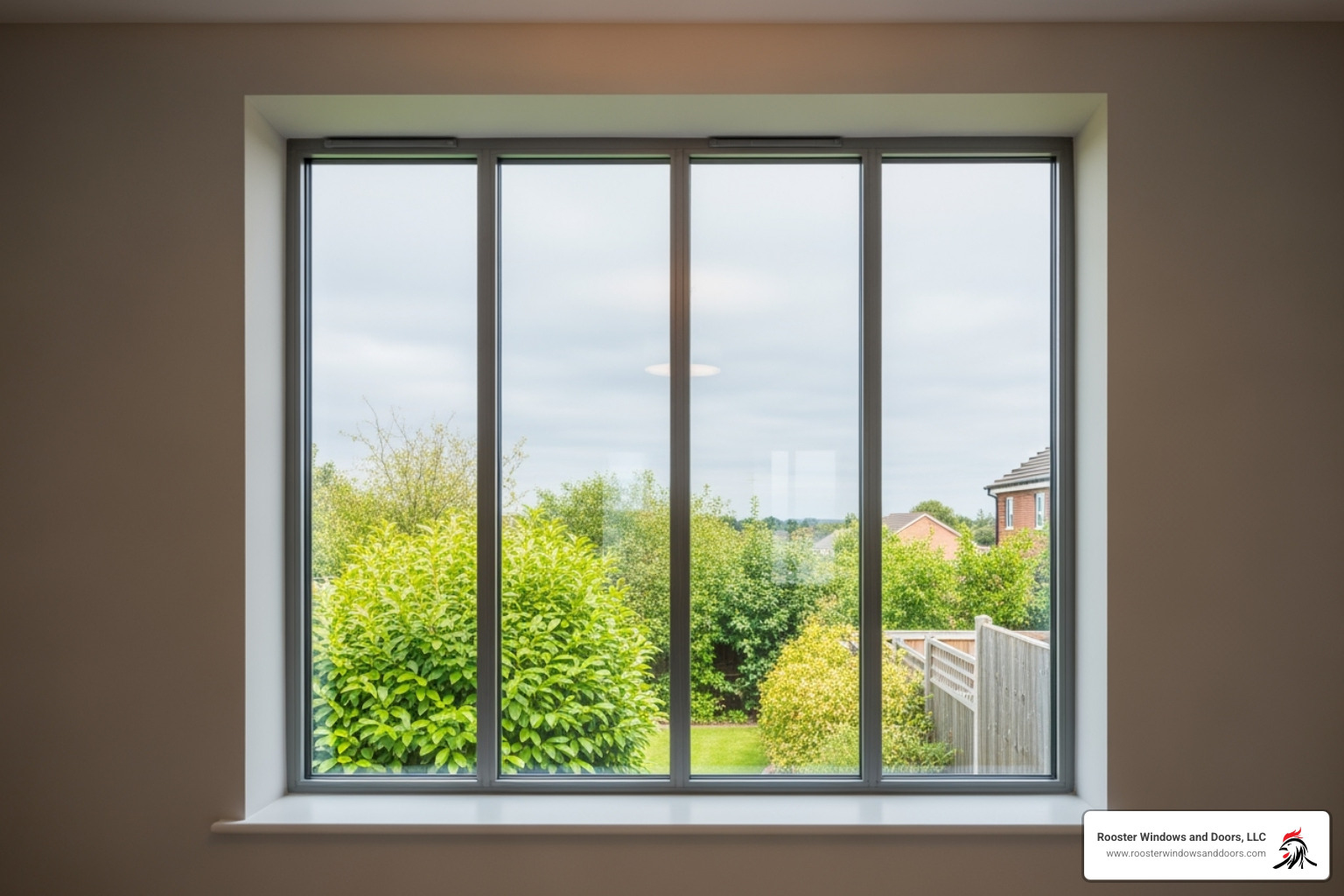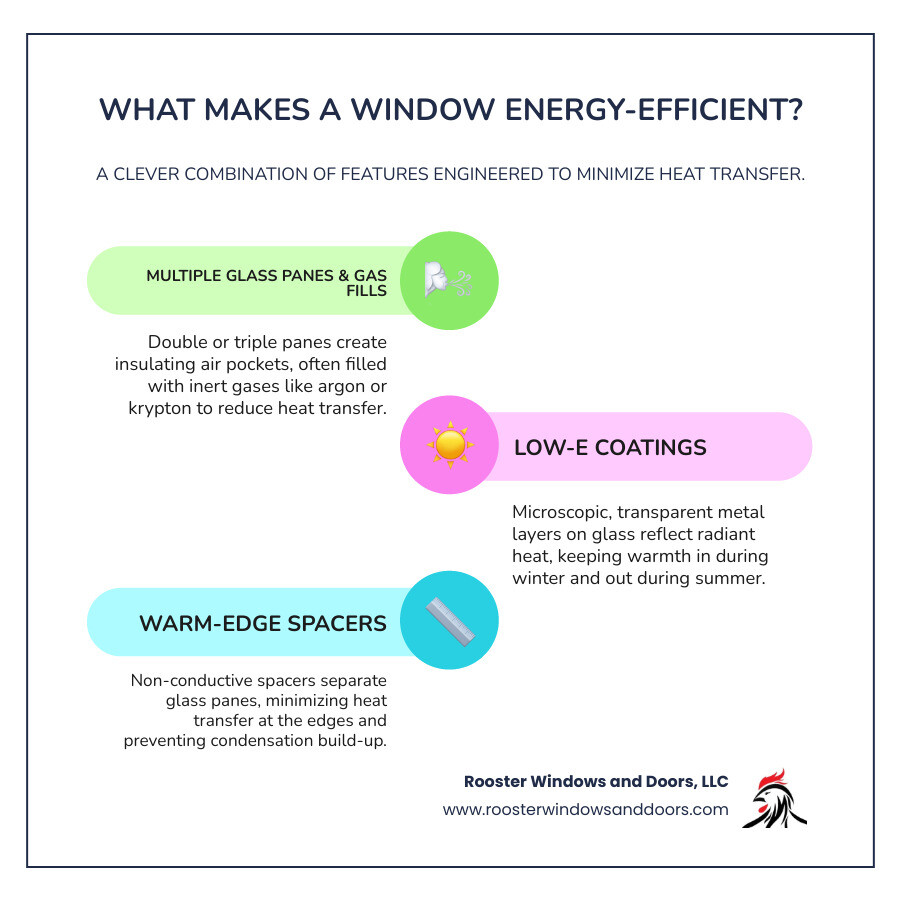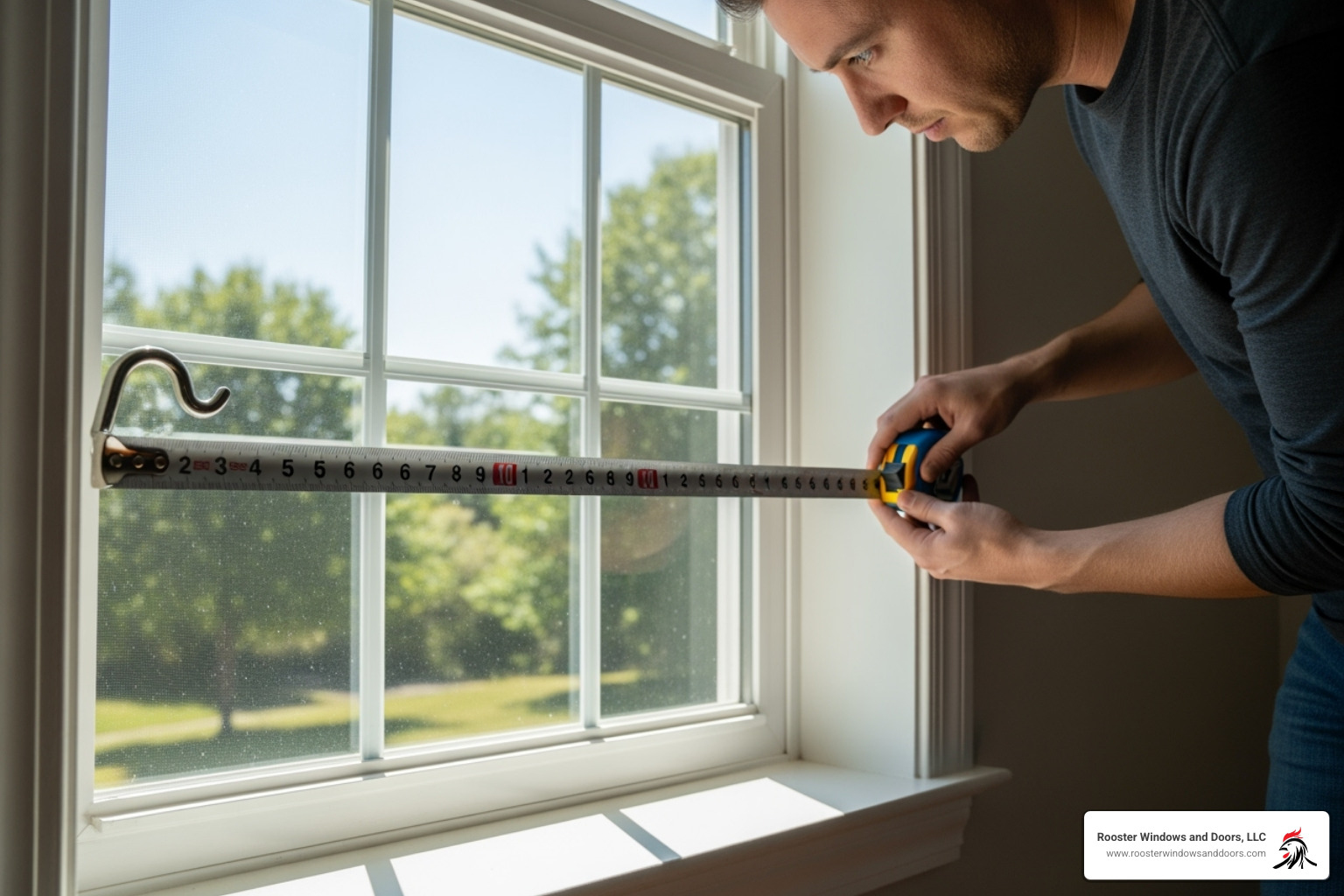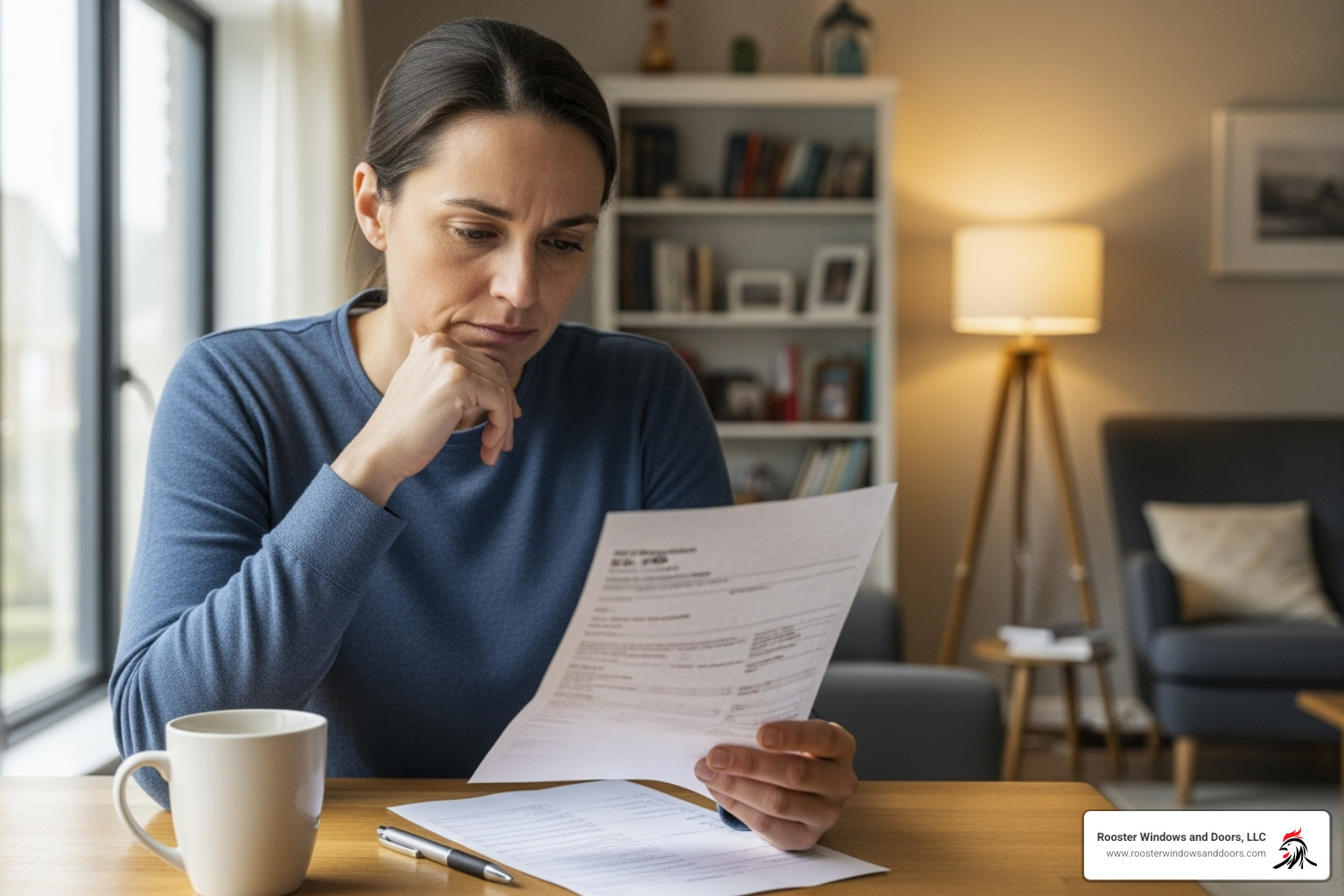The Investment Question Behind Energy-Efficient Window Upgrades

Energy efficient window prices typically range from $150 to $4,000 per window, with most homeowners paying around $400-$1,337 per window including installation. For a whole-house replacement, expect to invest $6,685 to $33,425 depending on your home’s size and window specifications.
Quick Price Breakdown:
- Double-pane windows: $150-$1,290 per window
- Triple-pane windows: $400-$3,540 per window (average $1,920)
- Professional installation: Additional $100-$300 per window
- Energy Star certified windows: Starting around $120 for basic models
- Annual energy savings: $101-$583 when replacing single-pane windows
When homeowners face the reality of window replacement costs, the natural question becomes: “Are these energy-efficient windows actually worth the higher price tag?” It’s a fair concern – after all, you could spend $30,000 replacing all the windows in your home.
The answer depends on understanding what you’re really buying. Energy-efficient windows aren’t just about the glass – they’re a complete system designed to reduce your home’s energy loss, which currently happens at a rate of 25-30% through your existing windows according to the U.S. Department of Energy.
As Piotr Wilk from Rooster Windows and Doors, I’ve helped Chicagoland homeowners steer energy efficient window prices and installation decisions for over two decades. Through thousands of installations, I’ve seen how the right windows transform both comfort and energy bills.

What Makes a Window Energy-Efficient?
Energy-efficient windows are designed to keep conditioned air in and bad weather out. Unlike old single-pane windows, today’s versions use multiple glass panes to create effective insulating barriers. The magic starts with double or triple-pane glass. Between each pane sits a carefully sealed space that acts as a thermal buffer. For a detailed comparison of how much difference this makes, check out our guide on Single Pane vs. Double Pane Windows.
That space between the glass isn’t filled with regular air. Instead, insulating gas fills like argon or krypton are used, as they are much better at slowing down heat transfer. Argon is the more budget-friendly option, while krypton offers slightly superior thermal performance, though it will affect energy efficient window prices.
The Low-E coating is a game-changer. These microscopic metallic layers on the glass can reflect up to 96% of heat energy, compared to just 16% from regular glass. This means your air conditioner can run less during the summer.
Warm-edge spacers are crucial for preventing cold spots around window edges that can cause condensation and heat loss. Traditional aluminum spacers conduct heat, while modern warm-edge spacers made from less conductive materials keep the thermal performance consistent across the entire window.
Finally, insulated frames complete the package. Whether made from vinyl, fiberglass, or wood, these frames provide that final barrier against unwanted heat transfer. All these components work together to create windows that earn their keep. Wondering if more panes are always better? Our article Are Triple Pane Windows Worth It? breaks down the cost-benefit analysis.
Understanding Window Performance Ratings
Understanding window performance ratings is crucial for making an informed purchase. The NFRC label (National Fenestration Rating Council) gives you the real performance story, and these numbers directly impact your energy efficient window prices and long-term savings.
The U-Factor measures how well your window insulates. Lower numbers mean better insulation, with efficient windows typically scoring between 0.2 and 0.5.
Solar Heat Gain Coefficient (SHGC) tells you how much of the sun’s heat makes it through your window. In Chicago’s climate, you might want some solar heat gain in winter but less in summer. This rating runs from 0 to 1, and the sweet spot depends on your specific needs.
Visible Transmittance (VT) measures how much natural light comes through. Higher VT numbers mean more natural light, which can reduce your need for artificial lighting.
Air Leakage ratings show how drafty your windows will be. Efficient windows typically score below 0.3. Condensation Resistance ratings (measured 1 to 100) tell you how well windows resist fogging up—higher numbers mean clearer views.
ENERGY STAR certification means the window has been independently tested and meets strict efficiency guidelines. These are verified performance standards that can significantly impact your energy bills. To find the right specifications for your area, use the Climate Zone Finder to understand what efficiency levels make sense for your local climate.
Understanding these ratings helps you make informed decisions about More info about Double Glazing Windows Near Me and ensures you’re getting the performance you’re paying for. You can find a comprehensive Guide to understanding NFRC labels on the NFRC website to dive deeper into these specifications.
A Breakdown of Energy Efficient Window Prices
Let’s get down to the numbers. When homeowners ask about energy efficient window prices, I explain that it’s a significant investment that pays dividends over time.

For individual windows, energy efficient window prices typically range from $150 to $4,000 per unit before installation. Most homeowners find themselves in the sweet spot around $400 per window, with the complete project averaging $1,337 including professional installation.
Planning a whole-house makeover? Complete window replacement projects typically run between $6,685 and $33,425. This wide range reflects the huge variety of choices available, from basic double-pane vinyl windows to premium triple-pane units with custom features.
Many homeowners don’t initially consider that professional installation is essential for performance. Our skilled teams charge $40-$65 per hour, adding roughly $100-$300 per window. When you combine materials and labor, expect each energy-efficient window to cost between $270 and $800, with high-end custom units pushing even higher.
Cost by Glass Type: Double vs. Triple-Pane
The glass configuration is a major decision for both performance and your wallet. Here’s a breakdown of the options.
Double-pane windows are the workhorses of energy efficiency, priced between $150 and $1,290 per window. They offer tremendous value and provide excellent insulation and comfort for most Chicagoland homes. They’re the sweet spot where performance meets affordability. Our guide on Double Glazing Windows Near Me covers this popular choice.
Triple-pane windows take performance to the next level, but they’ll stretch your budget. Expect to pay $400 to $3,540 per window, with most around $1,920. That’s typically 10-15% more than comparable double-pane units. For the extra cost, you get windows that are about 1.5 times more efficient than double-pane versions and provide superior noise reduction. For harsh Chicago winters or noisy streets, that extra investment often pays for itself in comfort alone.
Cost by Window Frame Material
Your frame choice dramatically impacts performance and price. Each material has different costs and maintenance needs.
Vinyl frames ($200-$600 per window) are popular for their excellent energy efficiency, low maintenance, and durability. They won’t rot, warp, or need painting, delivering the best bang for your buck.
Wood frames ($300-$800) provide natural beauty and superior insulation. The trade-off is regular maintenance (painting or staining) to protect against Chicago’s weather. Many clients choose wood for front-facing windows and vinyl elsewhere.
Fiberglass frames ($500-$1,000 per window) are a premium choice. They’re incredibly durable, highly energy-efficient, and low-maintenance, delivering exceptional long-term performance.
Aluminum frames ($300-$700) offer excellent durability with minimal maintenance. However, metal conducts heat, making them less energy-efficient than other options. They work for specific architectural styles but aren’t ideal if savings are your top priority.
Composite frames ($420-$2,500) blend materials like wood fibers and polymers. They aim to provide wood’s insulation with the low maintenance of synthetic materials. The wide price range reflects the variety of materials available.
Other Factors Influencing Energy Efficient Window Prices
Beyond glass and frames, other factors impact your final costs.
Window size affects pricing predictably. A compact 24″x36″ window might cost $150-$350, while a large 48″x60″ unit could run $350-$750. Bigger windows require more materials and longer installation.
Window style also creates cost variation. Double-hung windows are versatile and popular, typically costing $300-$600. Both sashes move for excellent ventilation. Check out our Double Hung Windows page for more information.
Casement windows ($350-$750) crank outward and create exceptional seals, making them highly energy-efficient. Picture windows ($250-$650) don’t open but offer expansive views and excellent efficiency.
Bay and bow windows are premium styles. These multi-panel units project outward, adding architectural impact and interior space. Their complexity drives costs to $500-$1,900 or more before installation.
Customization can increase costs. Special shapes, custom colors, advanced glass treatments, or integrated blinds all add to the base price and installation complexity.
Calculating the Payback: ROI, Energy Savings, and Incentives
Let’s be honest – when you’re staring at energy efficient window prices that could total $20,000 or more for your entire home, you want to know if this investment actually makes financial sense. The good news? Energy-efficient windows are one of the few home improvements that literally pay you back, month after month.

Think of energy-efficient windows as an investment that works around the clock. Every time your furnace kicks on in January or your air conditioner hums in July, these windows are quietly saving you money by keeping the heated or cooled air where it belongs – inside your home.
The Return on Investment (ROI) numbers tell a compelling story. According to Remodeling Magazine’s 2023 Cost versus Value Report, homeowners who install insulated vinyl windows with Low-E glass see an average ROI of 68.5%. That translates to roughly $13,766 in added home value. In other words, for every $100 you spend on quality windows, you’re likely to recoup about $68.50 when you sell your home.
But here’s where it gets really interesting – you don’t have to wait until you sell to see returns. The annual energy bill savings start immediately and continue for decades. The U.S. Department of Energy has found that 25-30% of your home’s heating and cooling energy escapes through inefficient windows. That’s like leaving money on the table every month.
When you replace those energy-wasting single-pane windows with Energy Star-certified models, you can expect to save $101 to $583 annually on your energy bills. Even if you’re upgrading from older double-pane windows with clear glass, you’ll still pocket an extra $20 to $70 per year. Over the 20-30 year lifespan of quality windows, these savings really add up.
The Energy Star program reports that replacing single-pane windows can lower your household energy bills by up to 13% on average. Your exact savings depend on your local climate, how many windows you’re replacing, and just how inefficient your current windows are. For detailed estimates specific to your situation, check out the Energy Star guide to window costs and energy savings.
Government Incentives and Tax Credits
Here’s where the math gets even better – the government actually wants to help you afford these upgrades. Various federal, state, and local incentives can significantly reduce those upfront energy efficient window prices.
The federal tax credit is the big one that most homeowners can take advantage of. If you install Energy Star-qualified windows between January 1, 2023, and December 31, 2032, you can claim 30% of your total project cost – both materials and labor – up to a maximum of $600. That’s real money back in your pocket at tax time. Starting in 2025, you’ll need to provide a Product Identification Number (PIN) from a qualified manufacturer, but that’s a small detail for such substantial savings. You can find all the specifics about details on the federal tax credit on the Energy Star website.
Don’t stop at federal incentives, though. State and local rebates can stack on top of federal credits, creating even more savings. Your local utility company might offer rebates for energy-efficient upgrades, or your state might have additional tax incentives. These programs change regularly, so it’s worth doing some homework.
The best resource I’ve found for tracking down these opportunities is DSIRE’s database of state incentives. It’s a comprehensive database that lists renewable energy and efficiency programs across the entire country, updated regularly as new programs launch and old ones expire.
When you factor in the immediate comfort improvements, long-term energy savings, increased home value, and available incentives, the investment in energy-efficient windows starts looking pretty smart. The key is choosing the right windows for your specific situation and having them professionally installed to maximize these benefits.
Installation and Upgrading Options
Once you decide to invest in energy-efficient windows, the success of your project hinges on professional installation. I’ve often seen high-performance windows compromised by poor installation.
Even the most advanced window is only as good as its installation. A poorly installed window can develop air leaks, moisture problems, and thermal bridging, negating your investment in energy efficient window prices.
DIY installation might seem like a way to save money, but the risks are substantial. Improper sealing can lead to drafts and water damage, incorrect measurements can result in gaps, and structural damage can be costly to repair. Plus, most manufacturers will void their warranties if installation isn’t done by certified professionals.
At Rooster Windows and Doors, we’ve perfected our installation techniques over two decades. Our teams understand proper installation requires precise measurement, flashing, sealing, and attention to thermal bridging. For a complete overview, check out our Window Installation Services: Complete Guide.
Improving the Performance of Your Current Windows
If a full replacement isn’t in your budget, several cost-effective improvements can boost your home’s energy efficiency and provide meaningful savings.
Sealing air leaks is often the most impactful improvement. If you feel drafts, you’re losing conditioned air. The Department of Energy offers a tutorial on detecting air leaks to help identify problem areas.
Weatherstripping seals movable window parts, while caulking fills gaps and cracks in fixed parts. These solutions cost just a few dollars per window but can make a noticeable difference.
Window film is another affordable upgrade. Applied to existing glass for about $0.50 per square foot, it helps reflect heat and adds some insulation.
Heavy curtains or insulated blinds create an additional thermal barrier. Storm windows (interior or exterior) add another air pocket for insulation and can significantly improve thermal performance.
These improvements can yield savings similar to a partial replacement for a fraction of the cost. They’re excellent interim solutions. To learn more, read our article on How to Insulate Windows.
Financing Your Window Replacement
Managing the investment in energy efficient window prices is a challenge, but several financing options can help.
Personal loans offer flexibility with fixed rates and predictable payments. They typically range from $1,000 to $100,000.
Home equity loans or HELOCs can be excellent choices if you have equity. They often have lower interest rates, and the interest may be tax-deductible.
Many companies offer installer financing. At Rooster Windows and Doors, we work with financing partners to provide convenient payment options. We always recommend comparing rates and terms to ensure you get the best deal.
When budgeting for your project, research average costs and get multiple quotes from reputable installers. Don’t forget to factor in federal tax credits and local rebates, which can significantly reduce your out-of-pocket costs.
For more detailed information, refer to our guide on the Cost to Replace a Window.
Frequently Asked Questions about Energy Efficient Window Prices
When exploring window replacement, homeowners often have the same questions. After helping thousands of Chicagoland families, I’ve noticed these three come up most often.
What is the average cost to replace all windows in a house with energy-efficient ones?
For a typical home, energy efficient window prices for a complete replacement usually fall between $6,685 and $33,425. This wide range is due to several factors.
The biggest factors are the number and size of your windows. A home with 15 small windows will cost less than one with 30 large windows. A standard double-hung window might run $400-$800 installed, while a large bay window could be $1,500-$3,000.
Your material choices also drive the final number. Choosing vinyl frames with double-pane glass keeps costs on the lower end, while fiberglass frames with triple-pane windows pushes you toward the higher range. Even at the higher end, it’s an investment that pays back through energy savings and increased home value.
How much can I realistically save on energy bills?
The savings can be significant. If you’re replacing old single-pane windows with Energy Star-certified models, you can realistically save $101 to $583 annually on your energy bills.
The Department of Energy states that windows account for 25-30% of a home’s energy loss. Plugging those leaks with efficient windows means your HVAC system works less, which makes a huge difference in the Chicago climate.
Even upgrading from older double-pane windows with clear glass will save $20 to $70 per year. These savings compound over the 20-30 year lifespan of your windows.
Your actual savings depend on your local climate, how many windows you replace, and what you’re replacing. The worse your current windows, the more dramatic your savings will be.
What is the most cost-effective energy-efficient window?
From our experience, double-pane vinyl windows with Low-E coatings offer the best value for most homeowners.
Here’s why this combination works: Vinyl frames are durable, low-maintenance, and provide excellent insulation at a reasonable price. Double-pane glass offers a massive efficiency jump over single-pane windows without the premium cost of triple-pane. The Low-E coating is the secret sauce, reflecting up to 96% of heat energy for a small additional cost.
This combination typically runs $300-$600 per window installed, making it accessible for most budgets while delivering serious energy savings and comfort improvements.
Is the Investment in Energy-Efficient Windows Right for You?
After delving into energy efficient window prices, factors, and benefits, you might be wondering if this investment is truly right for your home. We believe the answer, for most homeowners, is a resounding yes.
The upfront cost can seem daunting, but look at the bigger picture. You’re not just buying windows; you’re investing in:
- Improved Comfort: Say goodbye to drafty rooms and uneven temperatures. New windows create a more stable and pleasant indoor environment year-round.
- Lower Energy Bills: This is where your investment truly pays off. The annual savings on heating and cooling can significantly offset the initial cost over time.
- Increased Home Value: Energy-efficient upgrades are highly sought after by homebuyers, making your property more attractive and potentially increasing its market value.
- Reduced Carbon Footprint: By consuming less energy, you’re also contributing to a healthier planet.
The key to realizing these benefits fully lies in choosing the right windows and, crucially, ensuring quality installation. At Rooster Windows and Doors, we are committed to providing Chicagoland homeowners with high-quality, flawless, and energy-efficient installations. We offer a wide variety of options to suit your specific needs and budget, ensuring your investment improves your home for years to come.
Ready to explore how energy-efficient windows can transform your home? We invite you to Explore your Window Replacement options with us today.
